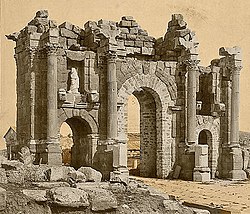Sbeitla
Sbeitla
سبيطلة | |
|---|---|
UTC1 (CET) | |
| Postal code | 1250[2] |
| Website | Sbeitla Official Website |
Sbeitla (
Sbeitla is the capital of the largest delegation in Kasserine Governorate with an area of 1133.5 km2.[3] It is located in 33 km in the west of the governorate, and 264 km to Tunis. It has a population of 23,844 (2014 estimate).[1] Sbeitla is mentioned in Norman Douglas's Fountains in the Sand as being wooded by junipers and Aleppo pines as late as the 19th century, though he found them "bleak and bare" in the early 20th century.[citation needed]
History
The oldest traces of civilisation in the zone are
The region was inhabited by nomadic tribes until the
Some inscriptions found in the city suggest that the settlement had success along the lines of others in North Africa during the 2nd century, reaching great prosperity through the olive industry, whose cultivation benefited from excellent climatic conditions in the region. The olive presses found in the ruins of the city further bolster this conclusion. The resulting prosperity made possible the construction of a splendid forum and other important buildings.
The city began to decline during the
The
-
Capitoline temples
-
Public baths
-
Arch of Antoninus Pius and Capitoline temples
The
The Muslim conquest marked the end of the
Geography
Sbeitla is located in western central Tunisia. By road it is 33 kilometres (29 mi) north-east of Kasserine, 246 kilometres (180 mi) south-west of Tunis, and 166 kilometres (141 mi) south-west of Sousse. The city is known by its semi-arid climate.
Culture
Thanks to the well preserved archaeological site with its prestigious Roman forum, the cultural activities in Sbeitla have prospered. An annual festival is organised in the forum.
Museums
The archaeological museum of Sbeitla houses several sculptures and
Festivals
Since 2000, the city holds its
Economy
The economy of Sbeitla relays on handicraft, agricultural and petroleum production managed by
Smuggling goods and oil from Algerian Borders represent a major parallel economy activity in the region.
Agricultural
The city is surrounded by a large field of agriculture of
| Irrigables Areas (ha) | irrigated Areas (ha) | Usage Rate (%) | Densification Rate (%) | ||||||||
|---|---|---|---|---|---|---|---|---|---|---|---|
| Public | Private | Total | Public | Private | Total | Public | Private | Total | Public | Private | Total |
| 992 | 2374 | 3366 | 794 | 2136 | 2930 | 80 | 100 | 90 | 110 | 111 | 111 |
Petroleum industries
The
Handicraft

The majority of handicraft known in Sbeitla relay on wool processing. Tunisian barnous is one of those handcrafts.
Sports
Sbeitla's most popular sport club is Union Sportive Sbeitla also known as USS, the club plays in the Tunisian ligue professionnelle 3 before being promoted to ligue 2 in the 2013 season . The team currently plays in the Third Tunisian League.
On June 5, 2013, the club advanced to the
Notable people
- Ali Ben Ghedhahem (1814 - October 10, 1867) a famous Tunisian revolutionary.
- Lotfi Ben Jeddou (July 31, 1964[11]) is a politician who was the Minister of the Interior from March 2013 to february 2015.
See also
- Sufetula (see), the former Catholic bishopric turned titular see
References
- ^ a b National Institute of Statistics - Tunisia
- ^ Postal code of Sbeïtla, GeoPostcodes
- ^ (in Arabic) Sbeitla in the official website of Kasserine Governorate
- ^ (in French) Official website of the Festival.
- ^ (in French) Sbeitla Festival International, did you said? Archived 2018-06-12 at the Wayback Machine, jetsetmagazine.net, Asma DRISSI, July 4, 2013
- ^ Official website of Sbeitla: Water Resources.
- ^ Annual CRDA 2007-2008 Archived 2013-10-12 at the Wayback Machine
- ^ (in Arabic) The Oil field of Doulab, ETAP Website
- ^ (in French)" Tunisian Cup : Stade Tunisien was eliminated by Union Sportive Sbeitla ", Mosaïque FM, juin 9, 2013
- ^ "Mongi Soussi Zarrouki Olympic Results". sports-reference.com. Archived from the original on 2020-04-18. Retrieved 2010-11-07.
- ^ (in French) Biography of Lotfi Ben Jeddou, Minister of the Interior, Express FM, January 27, 2014
External links
- Lexicorient Archived 2012-01-14 at the Wayback Machine




